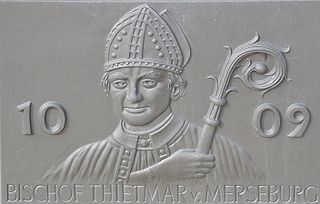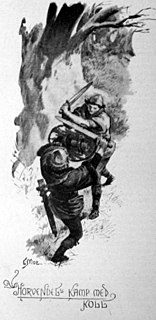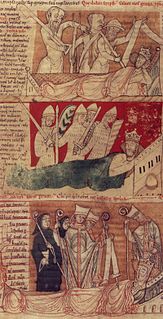A chronicle is a historical account of facts and events arranged in chronological order, as in a time line. Typically, equal weight is given for historically important events and local events, the purpose being the recording of events that occurred, seen from the perspective of the chronicler. This is in contrast to a narrative or history, which sets selected events in a meaningful interpretive context and excludes those the author does not see as important.
Æthelweard, descended from the Anglo-Saxon King Æthelred I of Wessex, the elder brother of Alfred the Great, was an ealdorman and the author of a Latin version of the Anglo-Saxon Chronicle known as the Chronicon Æthelweardi.
Saint Prosper of Aquitaine, a Christian writer and disciple of Saint Augustine of Hippo, was the first continuator of Jerome's Universal Chronicle.
Gregory Bar Hebraeus, also known by his Latin name Abulpharagius or Syriac name Mor Gregorios Bar Ebraya, was a maphrian-catholicos of the Syriac Orthodox Church in the 13th century. He is noted for his works concerning philosophy, poetry, language, history, and theology; he has been called "one of the most learned and versatile men from the Syriac Orthodox Church".
Chronicon Lethrense is a small Danish medieval work from the 12th century, written in Latin.

William Fleetwood was an English preacher, Bishop of St Asaph and Bishop of Ely, remembered by economists and statisticians for constructing a price index in his Chronicon Preciosum of 1707.
Chronicon Paschale, also called Chronicum Alexandrinum, Constantinopolitanum or Fasti Siculi, is the conventional name of a 7th-century Greek Christian chronicle of the world. Its name comes from its system of chronology based on the Christian paschal cycle; its Greek author named it Epitome of the ages from Adam the first man to the 20th year of the reign of the most August Heraclius.
The Chronicon or Chronicle was a work in two books by Eusebius of Caesarea. It seems to have been compiled in the early 4th century. It contained a world chronicle from Abraham until the vicennalia of Constantine I in A.D. 325. Book 1 contained sets of extracts from earlier writers; book 2 contained a technically innovative list of dates and events in tabular format.

The Chronicon Pictum is a medieval illustrated chronicle from the Kingdom of Hungary from the second half of the fourteenth century. It represents the international artistic style of the royal courts in the court of Louis I of Hungary.

Chronica Hungarorum is the title of several works treating the early Hungarian history.
Chronicon Scotorum, also known as Chronicum Scotorum, is a medieval Irish chronicle.
Ralph of Coggeshall, English chronicler, was at first a monk and afterwards sixth abbot (1207–1218) of Coggeshall Abbey, an Essex foundation of the Cistercian order.

Thietmar, Prince-Bishop of Merseburg from 1009 until his death, was an important chronicler recording the reigns of German kings and Holy Roman Emperors of the Ottonian (Saxon) dynasty. Two of Thietmar's great-grandfathers, both referred to as Liuthar, were the Saxon nobles Lothar II, Count of Stade, and Lothar I, Count of Walbeck. They were both killed fighting the Slavs at the Battle of Lenzen.
Cinioch, named Cínaed mac Luchtren in the Irish Annals, was king of the Picts, in modern Scotland, from circa 616 to 631, when his death is reported in the Annals of Ulster, the Annals of Tigernach and the Chronicon Scotorum.

Horwendill is a legendary Jutish chieftain in Chronicon Lethrense and in Saxo Grammaticus' Gesta Danorum.

John of Worcester was an English monk and chronicler who worked at Worcester Priory. He is usually held to be the author of the Chronicon ex chronicis.
Cacht ingen Ragnaill was the queen of Donnchad mac Briain, from their marriage in 1032 to her death in 1054, when she is styled Queen of Ireland in the Irish annals of the Clonmacnoise group: the Annals of Tigernach and Chronicon Scotorum. Her husband himself, though King of Munster, is not widely regarded as having been High King of Ireland and so the extent of Cacht's influence is uncertain. That her style is superior to his presents an obviously strange situation in medieval Gaelic Ireland's male-dominated politics.
Gumal was a diocese of the Syriac Orthodox Church. Bishops of Gumal are attested between the sixth and tenth centuries, but the diocese may have persisted into the thirteenth century.
Siderus was a port town of ancient Lycia, referenced in the Periplus of Pseudo-Scylax and the Stadiasmus Maris Magni. The town is also noted by Stephanus of Byzantium under the name Sidarus or Sidarous (Σιδαροῦς). The place may also have borne the name Posidarisus or Posidarisous, mentioned in The Chronicon of Hippolytus as being 30 stadia from Crambousa and the same distance from Moron Hydor.
Moron Hydor was a port town of ancient Lycia, located 30 stadia from Posidarisus, and 50 stadia from Cape Hieron and Chelidonia.